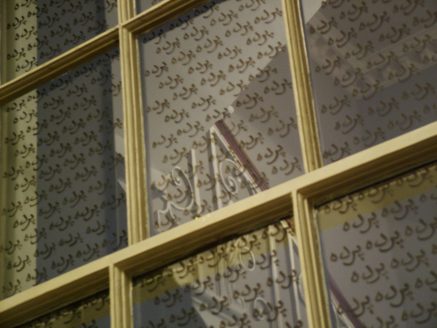
For An Embellishment: Purdah,[i] a two-part text installation for an exhibition, Spatial Imagination (2006), I selected twelve short extracts from ‘To Miss the Desert’ and rewrote them as ‘scenes’ of equal length, laid out in the catalogue as a grid, three squares wide by four high, to match the twelve panes of glass in the west-facing window of the gallery looking onto the street. Here, across the glass, I repeatedly wrote the word ‘purdah’ in black kohl in the script of Afghanistan’s official languages – Dari and Pashto.[ii]
Publication Details: ‘An Embellishment: Purdah’ in Sarah Hirschman (ed.) Sex, Special issue of the MIT Journal Thresholds, n. 37 (2010).
http://thresholds.mit.edu/issue/37.html
[i] See Jane Rendell, An Embellishment: Purdah (2006), in Spatial Imagination, domoBaal contemporary art, London with an associated catalogue essay Jane Rendell, ‘An Embellishment’, Peg Rawes and Jane Rendell (eds), Spatial Imagination (London: The Bartlett School of Architecture, UCL, 2005), pp. 34–5. In 2005–06 I directed a research cluster called Spatial Imagination in Design, which involved artists, architects and writers exploring the spatial imagination through the production of artefacts for an exhibition at domoBaal contemporary art, London. See www.spatialimagination.org.uk. (accessed 8 July 2008). This text was first published in this form in Jane Rendell, Site-Writing: The Architecture of Art Criticism (London: IB Tauris, 2010). See also ‘Site-Writing: Enigma and Embellishment’, Jane Rendell, Jonathan Hill, Murray Fraser and Mark Dorrian (eds) Critical Architecture (London: Routledge, 2007), pp. 150–162.
[ii] Afghanistan’s official languages Dari, a version of Persian, and Pashto are written primarily in the Arabic alphabet. One report states that Dari is spoken by the Tajiks (25–30 per cent of the Afghan population) and Pashto by the Pashtuns (45–50 per cent of the Afghan population). See Physicians for Human Rights, Women’s Health and Human Rights in Afghanistan: A Population-Based Assessment (31 December 2001), p. 17. However, another source holds that ‘according to recent US government estimates, approximately 35 percent of the Afghan population speaks Pashto, and about 50 percent speaks Dari’. http://www.afghan-web.com/language/ (accessed 14 May 2008).













































